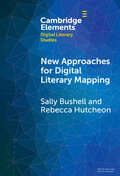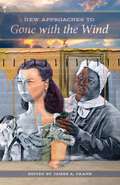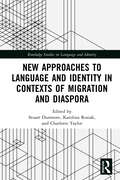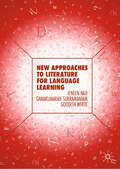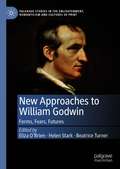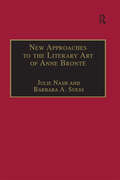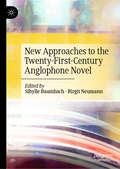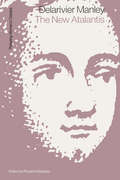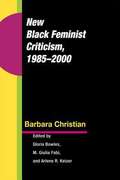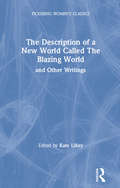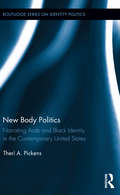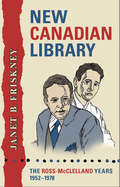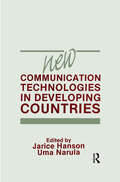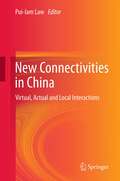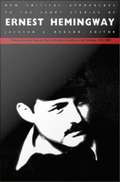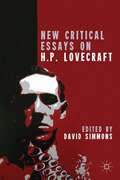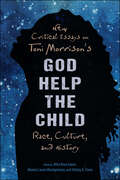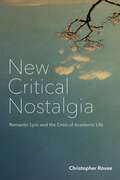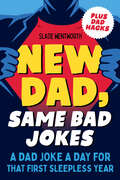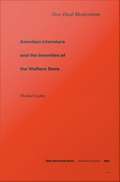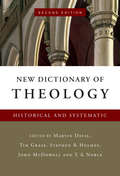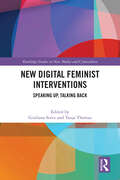- Table View
- List View
New Approaches for Digital Literary Mapping: Chronotopic Cartography (Elements in Digital Literary Studies)
by Sally Bushell Rebecca Louise HutcheonThis Element reconsiders what the focus of digital literary mapping should be for a subject like English Literature, what digital tools should be employed and to what interpretative ends. How we can harness the digital to find new ways of understanding spatial meaning in the Humanities? Section 1 provides a brief overview of the relationship between literature, geography and cartography and the emergence of literary mapping, providing a critique of current digital methods and making the case for new approaches. The second section turns to Russian theorist Mikhail Bakhtin and explores the potential of the 'chronotope' for literature as a way of structuring digital literary maps that provides a solution to the complexities of mapping time as well as space. Sections 3 and 4 then exemplify the method by applying it first to realist novels by Dickens and Hardy then the multiple states of J. M. Barrie's Peter Pan. This title is also available as Open Access on Cambridge Core.
New Approaches to Gone With the Wind (Southern Literary Studies)
by James A. CrankSince its publication in 1936, Gone with the Wind has held a unique position in American cultural memory, both for its particular vision of the American South in the age of the Civil War and for its often controversial portrayals of race, gender, and class. New Approaches to "Gone with the Wind" offers neither apology nor rehabilitation for the novel and its Oscar-winning film adaptation. Instead, the nine essays provide distinct, compelling insights that challenge and complicate conventional associations. Racial and sexual identity form a cornerstone of the collection: Mark C. Jerng and Charlene Regester each examine Margaret Mitchell's reframing of traditional racial identities and the impact on audience sympathy and engagement. Jessica Sims mines Mitchell's depiction of childbirth for what it reveals about changing ideas of femininity in a postplantation economy, while Deborah Barker explores transgressive sexuality in the film version by comparing it to the depiction of rape in D. W. Griffith's earlier silent classic, Birth of a Nation. Other essays position the novel and film within the context of their legacy and their impact on national and international audiences. Amy Clukey and James Crank inspect the reception of Gone with the Wind by Irish critics and gay communities, respectively. Daniel Cross Turner, Keaghan Turner, and Riché Richardson consider its aesthetic impact and mythology, and the ways that contemporary writers and artists, such as Natasha Trethewey and Kara Walker, have engaged with the work. Finally, Helen Taylor sums up the pervading influence that Gone with the Wind continues to exert on audiences in both America and Britain. Through an emphasis on intertextuality, sexuality, and questions of audience and identity, these essayists deepen the ongoing conversation about the cultural impact and influence of this monumental work. Flawed in many ways yet successful beyond its time, Gone with the Wind remains a touchstone in southern studies.
New Approaches to Language and Identity in Contexts of Migration and Diaspora (Routledge Studies in Language and Identity)
by Charlotte Taylor Stuart Dunmore Karolina RosiakNew Approaches to Language and Identity in Contexts of Migration and Diaspora draws together expertise and contemporary research findings in respect of language and identity in migrant and diasporic contexts throughout the world.Over thirteen chapters, contributors examine the intersection between migration, language, and identity through analyses of migration discourses, language practices, and legal policy, as well as the ideologies embedded and revealed within them. A wide range of subject areas and interdisciplinary approaches are represented, with fifteen authors drawn from the fields of education, intercultural communication, linguistics, geography, migration studies, psychology, and sociology.This volume will primarily appeal to scholars and researchers in fields such as migration, intercultural communication, sociolinguistics, bilingualism, multilingualism, and heritage language learning.
New Approaches to Literature for Language Learning
by Goodith White Jeneen Naji Ganakumaran SubramaniamThis book unpacks recent changes in the landscape of literature and language teaching, and aims to find new explanations for the altered relationships between readers and writers, the democratisation of authorship, and the emergence of new ways of using language. By examining topics as various as literature and technology, multimodality, and new Englishes, the authors take a fresh look at the use of literature as a tool in the teaching of English to second-language speakers. More than simply a way of teaching aesthetic and ethical values and rhetorical skills, they argue that literature can also be used to help students to critically evaluate assumptions about society, culture and power which underpin the production and reception of texts. The book relates theories of language acquisition and literary criticism to examples of literary texts from a wide range of global literature in English, and discusses new ways of engaging with it, such as transmedia story telling, book blogs and slam poetry. It will be of interest to language teachers and teacher trainers, and to students and scholars of applied linguistics, TESOL, and digital literacies.
New Approaches to William Godwin: Forms, Fears, Futures (Palgrave Studies in the Enlightenment, Romanticism and Cultures of Print)
by Beatrice Turner Eliza O’Brien Helen StarkThis collection showcases work on William Godwin (1756-1836) foregrounding new critical approaches and uncovering new texts. Godwin is a familiar presence in scholarship on the Shelley-Godwin circle and on Dissenting intellectual circles, but the present collection considers him closely as an author and thinker on his own terms. The range of texts and topics covered by this collection will be of interest both to scholars familiar with Godwin and those approaching his work for the first time.
New Approaches to the Literary Art of Anne Brontë (The Nineteenth Century Series)
by Barbara A. SuessThis new essay collection brings together some of the top Brontë scholars working today, as well as new critical voices, to examine the many layers of Anne Brontë's fiction and other writings and to restore Brontë to her rightful place in literary history. Until very recently, Brontë's literary fate has been to live in the critical shadow of her older sisters, Charlotte and Emily, in spite of the fact that her two published novels, Agnes Grey and The Tenant of Wildfell Hall were widely read and discussed during her lifetime. From a variety of fields-including psychology, religion, social criticism and literary tradition-the contributors to New Approaches to the Literary Art of Anne Brontë re-assess her works as those of an artist, which demand the rigorous scholarship and attention that they receive here.
New Approaches to the Twenty-First-Century Anglophone Novel
by Sibylle Baumbach Birgit NeumannThis book discusses the complex ways in which the novel offers a vibrant arena for critically engaging with our contemporary world and scrutinises the genre's political, ethical, and aesthetic value. Far-reaching cultural, political, and technological changes during the past two decades have created new contexts for the novel, which have yet to be accounted for in literary studies. Addressing the need for fresh transdisciplinary approaches that explore these developments, the book focuses on the multifaceted responses of the novel to key global challenges, including migration and cosmopolitanism, posthumanism and ecosickness, human and animal rights, affect and biopolitics, human cognition and anxieties of inattention, and the transculturality of terror. By doing so, it testifies to the ongoing cultural relevance of the genre. Lastly, it examines a range of 21st-century Anglophone novels to encourage new critical discourses in literary studies.
New Atalantis (Pickering Women's Classics)
by Delarivier ManleyAn early example of satirical political writing by a woman. The book, with its blend of politics and sexuality, is based on the public and private lives of prominent politicians and society figures of the time.
New Black Feminist Criticism, 1985-2000
by M. Giulia Fabi Arlene Keizer Gloria Bowles Barbara ChristianA passionate and celebrated pioneer in her own words New Black Feminist Criticism, 1985-2000 collects a selection of essays and reviews from Barbara Christian, one of the founding voices in black feminist literary criticism. Published between the release of her second landmark book Black Feminist Criticism and her death, these writings include eloquent reviews, evaluations of black feminist criticism as a discipline, reflections on black feminism in the academy, and essays on Toni Morrison, Alice Walker, Paule Marshall, and others.
New Blazing World and Other Writings
by Kate Lilley"New Blazing World" (1666), is one of the earliest pieces of science fiction, telling the story of a voyage to a Utopian World. The Duchess of Newcastle (1623-73) was fascinated by contemporary science, and wove it into her writings. She was a colourful figure as well as a popular author.
New Body Politics: Narrating Arab and Black Identity in the Contemporary United States (Routledge Series on Identity Politics)
by Therí A. PickensIn the increasingly multi-racial and multi-ethnic American landscape of the present, understanding and bridging dynamic cross-cultural conversations about social and political concerns becomes a complicated humanistic project. How do everyday embodied experiences transform from being anecdotal to having social and political significance? What can the experience of corporeality offer social and political discourse? And, how does that discourse change when those bodies belong to Arab Americans and African Americans? Therí A. Pickens discusses a range of literary, cultural, and archival material where narratives emphasize embodied experience to examine how these experiences constitute Arab Americans and African Americans as social and political subjects. Pickens argues that Arab American and African American narratives rely on the body’s fragility, rather than its exceptional strength or emotion, to create urgent social and political critiques. The creators of these narratives find potential in mundane experiences such as breathing, touch, illness, pain, and death. Each chapter in this book focuses on one of these everyday embodied experiences and examines how authors mobilize that fragility to create social and political commentary. Pickens discusses how the authors' focus on quotidian experiences complicates their critiques of the nation state, domestic and international politics, exile, cultural mores, and the medical establishment. New Body Politics participates in a vibrant interdisciplinary conversation about cross-ethnic studies, American literature, and Arab American literature. Using intercultural analysis, Pickens explores issues of the body and representation that will be relevant to fields as varied as Political Science, African American Studies, Arab American Studies, and Disability Studies.
New Canadian Library
by Janet FriskneyIn the mid-1950s, much Canadian literature was out of print, making it relatively inaccessible to readers, including those studying the subject in schools and universities. When English professor Malcolm Ross approached Toronto publisher Jack McClelland in 1952 to propose a Canadian literary reprint series, it was still the accepted wisdom among publishers that Canadian literature was of insufficient interest to the educational market to merit any great publishing risks. Eventually convinced by Ross that a latent market for Canadian literary reprints did indeed exist, McClelland & Stewart launched the New Canadian Library (NCL) series in 1958, with Ross as its general editor. In 2008, the NCL will celebrate a half-century of publication.In New Canadian Library, Janet B. Friskney takes the reader through the early history of the NCL series, focusing on the period up to 1978 when Malcolm Ross retired as general editor. A wealth of archival resources, published reviews, and the NCL volumes themselves are used to survey the working relationship between Ross and McClelland, as well as the collaborative participation of those who, through the middle decades of the twentieth century, were committed to studying and nurturing Canada's literary heritage. To place the New Canadian Library in its proper historical context, Friskney examines the simultaneous development of Canadian literary studies as a legitimate area of research and teaching in academe and acknowledges the NCL as a milestone in Canadian publishing history.
New Communication Technologies in Developing Countries: New Communication Technologies In Developing Countries (Routledge Communication Series)
by Jarice Hanson Uma NarulaThis volume explores how a number of developing countries -- including India, Malaysia, Columbia, Brazil, and Saudi Arabia -- are responding to the pressures of the information society. Infrastructural development, policies, and social systems are investigated, and models of information technologies and society are proposed in order to better reference the differences and similarities among the nations profiled. The authors identify the social technology perspective via the assimilation of technology in lifestyles and social systems. From this perspective, the diffusion of technologies is analyzed with a critical eye for theories of culture lag, diffusion and innovation, and technological determinism and liberalism. The social perspective is a new addition to development studies, and the reader may see how, as the global information society comes into focus, the social dimensions are more important than some theorists originally envisioned.
New Connectivities in China
by Pui-Lam LawThe fast diffusion of information and communication technologies (ICTs) in China has brought forth new forms of connection among the Chinese and has changed their social lives. Virtual networks have been developed and in turn have led to the formation of networks in the actual world. This collection explores the resultant complications in the relationship between virtual, actual, and local interactions. It discusses various aspects of the implications of the new connectivities on these three types of interactions in China. The topics examined include: the possibility of the development of civil society in China, the implications for the migrant workers in the south, the challenge posed to the traditional social order, and the relationship between the new connectivities and the Chinese social context.
New Critical Approaches to the Short Stories of Ernest Hemingway
by Jackson J. BensonWith an Overview by Paul Smith and a Checklist to Hemingway Criticism, 1975-1990 New Critical Approaches to the Short Stories of Ernest Hemingway is an all-new sequel to Benson's highly acclaimed 1975 book, which provided the first comprehensive anthology of criticism of Ernest Hemingway's masterful short stories. Since that time the availability of Hemingway's papers, coupled with new critical and theoretical approaches, has enlivened and enlarged the field of American literary studies. This companion volume reflects current scholarship and draws together essays that were either published during the past decade or written for this collection. The contributors interpret a variety of individual stories from a number of different critical points of view--from a Lacanian reading of Hemingway's "After the Storm" to a semiotic analysis of "A Very Short Story" to an historical-biographical analysis of "Old Man at the Bridge. " In identifying the short story as one of Hemingway's principal thematic and technical tools, this volume reaffirms a focus on the short story as Hemingway's best work. An overview essay covers Hemingway criticism published since the last volume, and the bibliographical checklist to Hemingway short fiction criticism, which covers 1975 to mid-1989, has doubled in size. Contributors. Debra A. Moddelmog, Ben Stotzfus, Robert Scholes, Hubert Zapf, Susan F. Beegel, Nina Baym, William Braasch Watson, Kenneth Lynn, Gerry Brenner, Steven K. Hoffman, E. R. Hagemann, Robert W. Lewis, Wayne Kvam, George Monteiro, Scott Donaldson, Bernard Oldsey, Warren Bennett, Kenneth G. Johnston, Richard McCann, Robert P. Weeks, Amberys R. Whittle, Pamela Smiley, Jeffrey Meyers, Robert E. Fleming, David R. Johnson, Howard L. Hannum, Larry Edgerton, William Adair, Alice Hall Petry, Lawrence H. Martin Jr. , Paul Smith
New Critical Essays On Kurt Vonnegut
by David SimmonsKurt Vonnegut's darkly comic work became a symbol for the counterculture of a generation. From his debut novel, Player Piano (1951) through seminal 1960's novels such as Cat's Cradle (1963) and Slaughterhouse-Five (1969) up to the recent success of A Man Without A Country (2005), Vonnegut's writing has remained commercially popular, offering a satirical yet optimistic outlook on modern life. Though many fellow writers admired Vonnegut - Gore Vidal famously suggesting that "Kurt was never dull" - the academic establishment has tended to retain a degree of scepticism concerning the validity of his work. This dynamic collection aims to re-evaluate Vonnegut's position as an integral part of the American post-war cannon of literature.
New Critical Essays on James Agee and Walker Evans
by Caroline BlinderCoinciding with the increasing intersections between visual and literary studies, this timely reappraisal of Let Us Now Praise Famous Men sheds light on the book's unclassifiable status as part imaginative fiction, documentary effort, ethnographic study, and modernist prose.
New Critical Essays on Toni Morrison's God Help the Child: Race, Culture, and History
by Alice Knox Eaton, Maxine Lavon Montgomery, and Shirley A. StaveContributions by Alice Knox Eaton, Mar Gallego, Maxine Lavon Montgomery, Evelyn Jaffe Schreiber, Shirley A. Stave, Justine Tally, Susana Vega-González, and Anissa Wardi In her eleventh novel, God Help the Child, Toni Morrison returned to several of the signature themes explored in her previous work: pernicious beauty standards for women, particularly African American women; mother-child relationships; racism and colorism; and child sexual abuse. God Help the Child, published in 2015, is set in the contemporary period, unlike all of her previous novels. The contemporary setting is ultimately incidental to the project of the novel, however; as with Morrison’s other work, the story takes on mythic qualities, and the larger-than-life themes lend themselves to allegorical and symbolic readings that resonate in light of both contemporary and historical issues. New Critical Essays on Toni Morrison's “God Help the Child”: Race, Culture, and History, a collection of eight essays by both seasoned Morrison scholars as well as new and rising scholars, takes on the novel in a nuanced and insightful analysis, interpreting it in relation to Morrison’s earlier work as well as locating it within ongoing debates in literary and other academic disciplines engaged with African American literature. The volume is divided into three sections. The first focuses on trauma—both the pain and suffering caused by neglect and abuse, as well as healing and understanding. The second section considers narrative choices, concentrating on experimentation and reader engagement. The third section turns a comparative eye to Morrison's fictional canon, from her debut work of fiction, The Bluest Eye, until the present. These essays build on previous studies of Morrison’s novels and deepen readers’ understanding of both her last novel and her larger literary output.
New Critical Nostalgia: Romantic Lyric and the Crisis of Academic Life (Lit Z)
by Christopher RoveeNew Critical Nostalgia weighs the future of literary study by reassessing its past. It tracks today's impassioned debates about method back to the discipline’s early professional era, when an unprecedented makeover of American higher education with far-reaching social consequences resulted in what we might call our first crisis of academic life. Rovee probes literary study’s nostalgic attachments to this past, by recasting an essential episode in the historiography of English—the vigorous rejection of romanticism by American New Critics—in the new light of the American university’s tectonic growth. In the process, he demonstrates literary study’s profound investment in romanticism and reveals the romantic lyric’s special affect, nostalgia, as having been part of English’s professional identity all along. New Critical Nostalgia meticulously shows what is lost in reducing mid-century American criticism and the intense, quirky, and unpredictable writings of central figures, such as Cleanth Brooks, Josephine Miles, and W. K. Wimsatt, to a glib monolith of New Critical anti-romanticism. In Rovee’s historically rich account, grounded in analysis of critical texts and enlivened by archival study, readers discover John Crowe Ransom’s and William Wordsworth’s shared existential nostalgia, witness the demolition of the “immature” Percy Shelley in the revolutionary textbook Understanding Poetry, explore the classroom give-and-take prompted by the close reading of John Keats, consider the strange ambivalence toward Lord Byron on the part of formalist critics and romantic scholars alike, and encounter the strikingly contemporary quantitative studies by one of the mid-century’s preeminent poetry scholars, Josephine Miles. These complex and enthralling engagements with the romantic lyric introduce the reader to a dynamic intellectual milieu, in which professionals with varying methodological commitments (from New Critics to computationalists), working in radically different academic locales (from Nashville and New Haven to Baton Rouge and Berkeley), wrangled over what it means to read, with nothing less than the future of the discipline at stake.
New Dad, Same Bad Jokes: A Dad Joke a Day for That First Sleepless Year
by Slade WentworthQ: Why is that baby still in diapers?A: I&’ll give you two reasons: number one and number two.Calling new dads! Cackle and eye-roll your way through baby&’s first year with 365 hilariously horrible dad jokes for parents who have no idea what they&’re in for. Classically corny plus new cringe, these jokes help first-time dads take a load off, tickle their loved ones, and give baby their first giggly groan. New Dad, Same Bad Jokes won&’t make it easier to be a new parent, but it will soften the blow with some hearty LOLs, new-dad tips, and prompts to document the messy, endearing, and hilarious moments of first-time fatherhood. While baby might still be little, this dad joke book is full-groan!Inside, Dad will find: A joke a day for baby&’s first year! Baby jokes and a whole lot more. 365 classic puns, one-liners, and Q&As to give you a zing when that coffee won&’t quite cut it.Hilariously useful Dad Hacks. Stop pee mid-air? Wrap baby like a burrito? Help mom eat one-handed? Tips you didn&’t know you needed to survive year one.Space to record early memories of baby. Prompts to jot down the sweet, the silly, the stinky as baby grows from swaddled to swindler.
New Deal Modernism: American Literature and the Invention of Welfare State
by Michael SzalayIn New Deal Modernism Michael Szalay examines the effect that the rise of the welfare state had on American modernism during the 1930s and 1940s, and, conversely, what difference this revised modernism made to the New Deal's famed invention of "Big Government. " Szalay situates his study within a liberal culture bent on security, a culture galvanized by its imagined need for private and public insurance. Taking up prominent exponents of social and economic security--such as Franklin Delano Roosevelt, John Maynard Keynes, and John Dewey--Szalay demonstrates how the New Deal's revision of free-market culture required rethinking the political function of aesthetics. Focusing in particular on the modernist fascination with the relation between form and audience, Szalay offers innovative accounts of Busby Berkeley, Jack London, James M. Cain, Robert Frost, Ayn Rand, Betty Smith, and Gertrude Stein, as well as extended analyses of the works of Ernest Hemingway, John Steinbeck, and Richard Wright.
New Deal Modernism: American Literature and the Invention of the Welfare State
by Michael SzalayA unique leterary criticism.
New Dictionary of Theology: Historical and Systematic
by Kevin J. Vanhoozer David Emmanuel Singh Roland ChiaThis classic one-volume reference work has been appreciated for decades. It is now substantially expanded and revised to focus on a variety of theological themes, thinkers and movements. From African Christian Theology to Zionism, this volume of historical and systematic theology offers a wealth of information and insight for students, pastors and all thoughtful Christians. Over half of the more than eight hundred articles are new or rewritten with hundreds more thoroughly revised. Fully one-third larger than its predecessor, this volume focusing on systematic and historical theology has added entries and material on theological writers and themes in North America and around the world. Helpful bibliographies have also been updated throughout. Over three hundred contributors form an international team of renowned scholars including Marcella Altaus-Reid, Richard Bauckham, David Bebbington, Kwame Bediako, Todd Billings, Oliver Crisp, Samuel Escobar, John Goldingay, Tremper Longman III, John McGuckin, Jennifer McNutt, Michael J. Nasir-Ali, Bradley Nassif, Mark Noll, Anthony Thiselton, John Webster and N. T. Wright. This new edition combines excellence in scholarship with a high standard of clarity and profound insight into current theological issues. Yet it avoids being unduly technical. Now an even more indispensable reference, this volume is a valuable primer and introduction to the grand spectrum of theology.
New Digital Feminist Interventions: Speaking Up, Talking Back (Routledge Studies in New Media and Cyberculture)
by Tanja Thomas Giuliana SorceThis volume proposes “speaking up” and “talking back” as new theoretical access points for studying feminist activism in digital spaces.Drawing on the influential work of bell hooks, it highlights social justice interventions by feminist/queer/decolonial actors, groups, and collectives who recover the digital as a space for activist organizing and campaigning. In presenting a variety of sociocultural issues, such as gender violence, queer discrimination, or migrant hostility, the book centers empowerment practices in their digital forms, showcasing interventions in Asia, Europe, and the Americas—thereby critically examining the conditions for marginalized voices to speak up, talk back, and be heard in digital publics. In focusing on activist practices, formats, experiences, and scholarship, the contributions analyze many facets of digital feminist contention, including resistance storytelling, hashtag activism, grassroots journalism, or diaspora podcasting.This international and interdisciplinary volume will interest students and scholars of Media and Communication, Social Movements and Activism, Cultural Studies, Gender and Queer Studies, and Race and Ethnicity.
